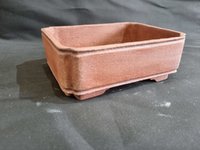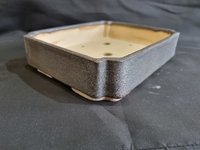Biggest pot I've made so far. (10x8 inch)
Left it to dry a bit over night in a plastic bag before attaching the feet and a hairline crack appeared on one if the corners!

Smoothed it over. Here's hoping it survives the bisque... (any tips on how to handle cracking while drying? First time its happened to me. I dry as slow as i possibly can most of the time)
This one's destined for a nice grey or orange/brown glaze.
Is the crack visible in the back right corner?
There is something to be said about how "slow drying" isn't just "slow drying".
When enclosed, there is also a redistribution of water, depending how tightly (footless on what type of surface?), this can mean a bottom slab that was already properly shrunk, expanding again, then pulling the walls apart when it reshrinks.
For all the no good reasons people believe in "s-cracks" at the bottom of thrown rounds, it is truly caused by the middle staying wet longer than the edge.
When the edge dries/shrinks first, especially in the strong shape of a round, the center can't shrink wholly, so it relieves it's stress and gets it's shrink.

This is to say, it is APPROPRIATE to have the edge of our pots the last thing wet, so it is slightly backpedaling to redistribute that water.
Appropriate drying isn't necessarily slow OR even.
Appropriate drying is what we must find for ourselves.
When all of our slabs are "dry", or mostly shrunk leather hard, and our joints are the last thing to shrink, we are in a *good physical position as far as clay action and avoiding "drying" cracks....

But it does open up the easy possibility of handling cracks, especially when applying feet, which tends to rewet the joints.
It could be something as simple as one drop of water running down that spot, but I think these considerations may help you figure it out.
The shape of that particular corner and how it would want to shrink both in and out is slightly contradictory to "*a good physical position as far as clay action and avoiding "drying" cracks".
Nice.
Sorce












